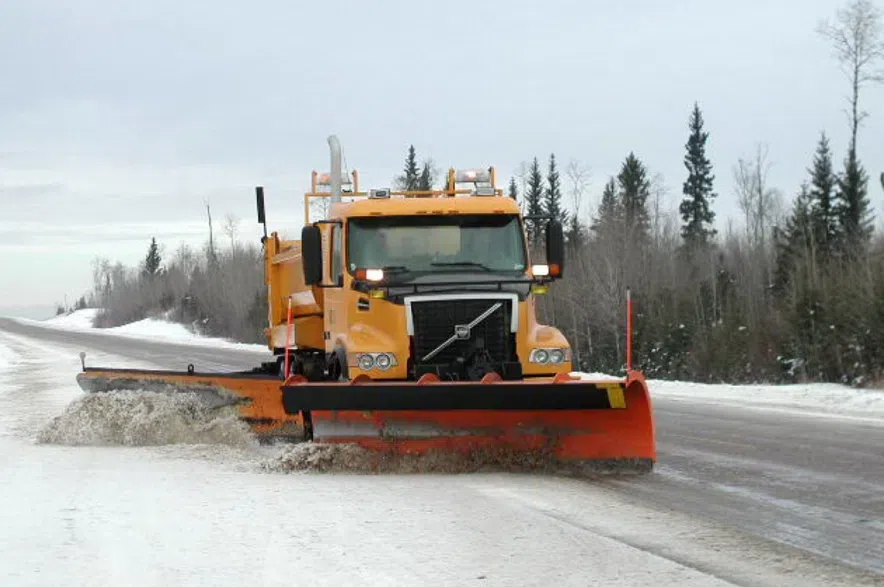Roads in the province continue to be treacherous, with Saskatchewan RCMP saying on Saturday the winter weather experienced this week was still causing problems.
In a late morning update, RCMP said that a police vehicle parked on the side of Highway 11 near Kenaston was hit by a semi around 1:30 p.m. on Friday, causing damage to the vehicle but no injury to officers, who were dealing with “multiple collisions” at the time.
Read more:
- All hands on deck to clear Saskatoon streets after snowstorm
- Saskatoon police looking for sedan after man was stabbed
- ‘We need a lot of room to do our job’: Safety top of mind for snowplow drivers
Environment and Climate Change Canada was forecasting any light snow still falling in the province to end by Saturday night, but temperatures dropping to the minus mid-teens overnight.
Travelling safely during winter driving conditions requires additional attention and skill, police said. When driving on slippery and /or snow-covered surfaces or with reduced visibility, motorists should:
Slow down: Travel at a speed that allows you to keep control of your vehicle, even if this is slower than the speed limit.
Make smooth manoeuvres: Make soft, fluid movements when steering, accelerating, and braking.
Refrain from using cruise control: If you go into a skid while using cruise control, your vehicle will continue to accelerate and the tires will spin, preventing you from stopping your vehicle.
Maintain a safe following distance: Leave additional space between your vehicle and the vehicle in front of you, allowing for sudden stops.
Stay on main roads: Main highways are first to be cleared and travelling on them increases your visibility if you get stranded.
Use your headlights: If it is snowing or raining, drive with your headlights on at all times.
RCMP also said motorists should check road conditions before travelling, and check the weather forecast, adding that if poor weather or road conditions exist or are forecast, they should consider delaying travel if possible.
If travel is necessary, police said drivers should stay on roads that have recently received road maintenance.
Travellers can access information on road conditions and see which roads have been plowed, salted, and/or sanded within the last two hours on the Highway Hotline map.
RCMP also asked that people avoid calling 911 or local RCMP detachments for updates on road conditions, adding that the 911 number should only be used for emergencies and crimes in progress. Using it in non-emergency situations could prevent someone with a life-threatening emergency from getting help, they said.

Many roads in the province were still partly or fully covered with snow on Saturday morning.(Highway Hotline/Screenshot)
What can drivers do be safe on winter roads?
Saskatchewan RCMP’s website suggests people take the following precautions to help keep drivers, passengers and other road users safe:
Stock your vehicle
All winter travellers should pack an emergency kit to be prepared for serious weather conditions or a roadside emergency, which should include:
- Additional warm clothing (including footwear, mittens, and toques)
- Candles and matches
- A tow chain or rope
- Nourishing, non-perishable food items (nuts, dried fruit, energy bars)
- Drinking water
- A blanket or sleeping bag
- A cellphone and charger
- A first aid kit with seatbelt cutter
- A flashlight
- A snow brush and shovel
- Traction mats, a bag of sand, or non-clumping cat litter for traction
- Booster cables
- Hand warmers
- A whistle
Before you drive
Prepare your vehicle appropriately for weather conditions by:
- Adding antifreeze to your radiator and gas line.
- Putting winter tires on your vehicle.
- Topping up windshield wiper fluid and ensuring windshield wipers are working.
- Scraping your windshield, rear and side windows, and brushing off all snow.
- Cleaning off headlights, tail lights, and signal lights.
- Clearing your heater air intake.
- Moving items away from defroster outlets inside the vehicle.
- Keeping your gas tank more than half full.
- Telling a family member or friend where you’re headed and when you expect to arrive.
- Familiarizing yourself with your route and don’t rely on GPS.
If you are stranded
If you find yourself in an emergency situation where you are stranded roadside:
Always stay with your vehicle: This is your best chance for survival and helps police locate you.
Stay warm: Periodically turn your vehicle on, but be mindful to conserve your fuel and battery. Put on your emergency winter clothing before you get cold, and use candles to keep warm if necessary.
Make sure your tailpipe remains clear: Ice and snow can block it, meaning carbon monoxide could potentially seep into your vehicle.
Get some fresh air: Periodically lower your window slightly on the side of your vehicle that is downwind, allowing for fresh air to enter the vehicle.
Be careful: When shovelling or trying to push your vehicle, do not overexert yourself.
Read more:
- All hands on deck to clear Saskatoon streets after snowstorm
- Saskatoon police looking for sedan after man was stabbed
- ‘We need a lot of room to do our job’: Safety top of mind for snowplow drivers











